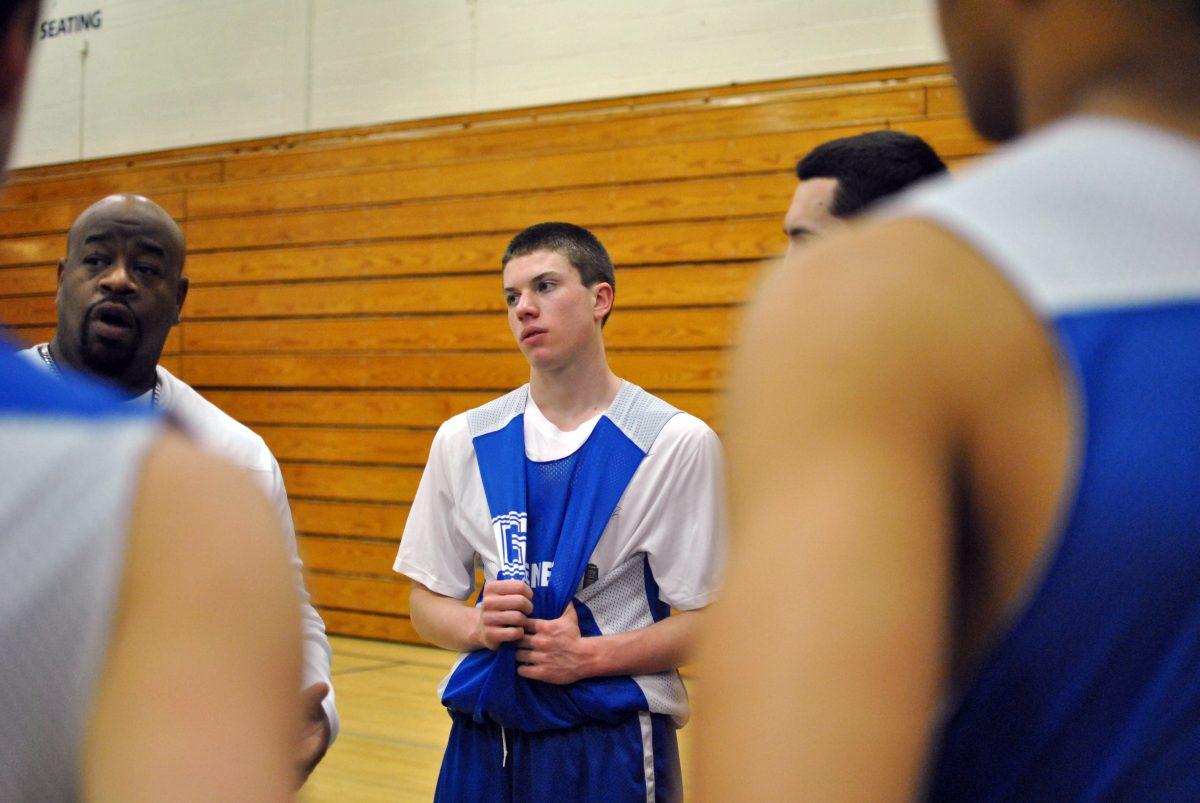Rummaging through haphazard containers at the Goodwill Bins, Grant High School junior Isabel Conley pulls out the perfect find – an old, oversized denim shirt that she will “fix” to create a trendier piece. An aspiring fashion designer, Conley says, “I usually cut off the sleeves and add studs to the collar.”
Donning leather pants, a statement shirt and a one-of-a-kind coat, senior Angela May – another fashionista – is attracted to the malleability of thrift fashion. “It’s always changing,” May says. “I want to have a future in the fashion industry. I would love to style and be a part of the runway and the process, dressing girls and doing make up.”
While some are drawn to the style aspect of thrifting, others say it represents a changing world. “My ultimate thrift shop is a costume room,” senior Mac Larsen says. “Maybe that is a little theater kid inside of me.” A long time actor, Larsen says he grew up “under the stage.”
At Grant, some students are dressed in the newest trend, purchasing full price gear from Nordstrom or Nike. But there is a growing number of teens who prefer to hunt through overflowing thrift stores, searching for the most stylish bargain. That outfit that you see in the hallway may look like it’s from a high-priced retail store but many students are doing savvy shopping to save money.
New, trendy vintage and second-hand stores dot the landscape from downtown to North Portland to Grant’s neighborhood in Northeast Portland. In the past, shopping at these places was a necessity for families that couldn’t afford to buy new clothes. But over time, buying second hand became trendy.
Barbara Bigler works at Zanzibar and Continuous Threads Quality Resale in the Hollywood area. She remembers raising her daughter, who is now 36, to shop at thrift stores. “My daughter would always be embarrassed if I went in one. Now it’s cool,” says Bigler.
Some students at Grant only occasionally thrift for specific items, and then there are the thrifters – people who only buy their clothes from hip vintage and second hand stores. The benefits are numerous. It’s easier on students’ wallets, it’s better for the environment, and it allows people to create a more authentic style that becomes part of who they are.
For Conley, thrift shopping runs in the family. Her father, Michael Conley, has been taking her thrifting since she was little and continues to recommend the best spots for fashionable bargain hunting. Michael Conley learned thrifting from his mother when she took him to antique shops. “I realized that I could get the little cars I collected for much cheaper if I bought them second hand,” he says. Then, in high school, Conley went to rummage sales with his friends and found some “really slick shirts.”
It wasn’t until the fifth grade when Isabel Conley went “real” shopping for the first time. “Before that, I wore mostly hand-me-downs from my dad’s friends kids or my grandma,” she says.
For her 16th birthday, Conley’s father took her thrifting on a budget. “Thrifting with my dad is a bonding experience,” Conley says.
She says that the more you thrift, the better finds you can get. “You really have to shop around,” she says. “You can find more unique clothes than if you shop where everyone else does.”
Conley refuses to buy some items at full price because she knows she can find them cheaper by taking the time to sift through the overflowing racks of her favorite stores in Portland, Astoria and on Northeast 82nd Avenue.
A member of the business leadership class, Conley is planning to create pieces of recycled fashion for the 2013 Grant trade show. “Usually, people are surprised at the things I find at thrift shops,” Conley says, “and you have to have confidence to wear them.”
But Conley encourages her friends to go thrift shopping. “People don’t usually judge you for buying used clothes,” Conley says, “and it’s a good way to develop a unique style.”
Mac Larsen says he thrift shops because times are tight. “Most people do,” he says. “It’s nice to find clothes that I find that I know I will wear that don’t cost $50.”
Larsen also appreciates the fact that thrifting isn’t considered embarrassing anymore. “Portland is definitely a lot more beyond the stereotype that thrifting is bad,” Larsen says. “It’s becoming hip in a lot of places.”
Larsen has mentally transformed his childhood costume shop into his ideal thrift shop. Instead of dressing up in costumes to become the character he’s playing, Larsen shops at thrift stores to dress his own character – himself. Larsen also dresses as if he is in a play, enjoying the aspect of finding his own costume whether from a thrift shop or his mother’s closet. “I like when stores give you sections like a costume shop,” Larsen says, “I definitely dress under the influence of actors.”
Whether he thrifts to dress his personality or to save some money, Larsen sees himself at the core of what thrifting is about. He enjoys the act of buying and selling clothes in order to dress in a truly unique way. As Larsen puts it: “I appreciate the vicious cycle.”
Some of the larger retailers that sell new merchandise may complain that thrifting cuts into their business. But according to Arron Dieter, an investment advisor for Umpqua Bank, thrifting still helps stimulate the economy and it’s good for the buyer because it saves a significant amount of money compared to buying at larger retailers.
And at the end of the day, “you’re choosing where to spend your dollar,” says Dieter.
With a major interest in fashion, Angela May tuned in to YouTube videos like “The Fashion Citizen and Clothes Encounters.”
“They’d film themselves going to Goodwill or a thrift store and put together amazing outfits,” May says. “I was inspired by their incredible fashion sense.”
May goes thrifting about once a month and mixes new and used clothes to create unique outfits. “Sometimes my entire outfit is from a thrift store, and sometimes only one piece,” May says. “You can’t even tell which pieces are new and which are used.”
May’s fashion sense has expanded since starting to thrift because she says she can find more authentic styles.
While some people might judge May for thrift shopping, she thinks the labels are shrinking. The common stereotype of a Goodwill shopper, May says, has changed. “People used to think that shoppers at thrift stores couldn’t afford to shop at the mall,” May says. “But it’s not like that now. People are trying to save money. If you get a $60 shirt at Nordstrom, the amount of clothes you could get at a thrift store for $60 is amazing.”
According to May, when more people wear used clothes, it opens people’s minds to a new way of shopping. “People don’t have to shop at Nordstrom to only find cute clothes,” May says, “You can be unconventional and still dress well.”
When thrifting, May keeps an open mind. “You have to want to explore,” she says. “You have to commit. It usually takes a longer shopping trip to find what you want.”



































